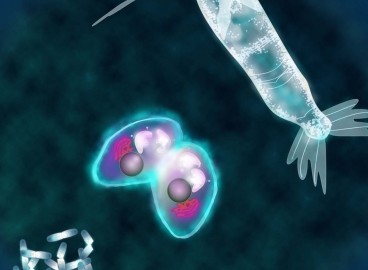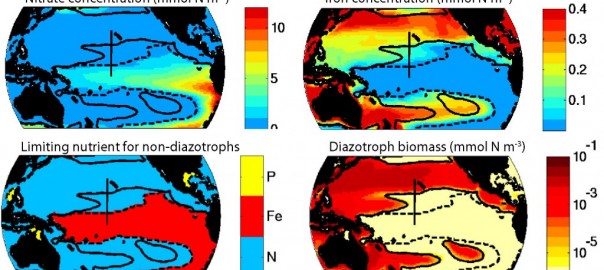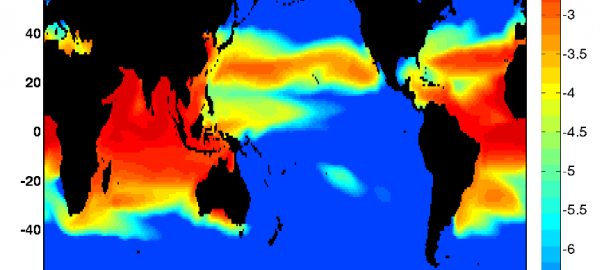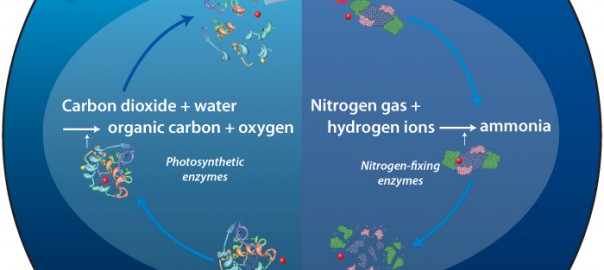Publication
Dutkiewicz, S., B. A. Ward, F. Monteiro, and M. J. Follows (2012), Interconnection of nitrogen fixers and iron in the Pacific Ocean: Theory and numerical simulations, Global Biogeochem. Cycles, 26, GB1012, doi: 10.1029/2011GB004039
Dutkiewicz, S., B. A. Ward, F. Monteiro, and M. J. Follows (2012), Interconnection of nitrogen fixers and iron in the Pacific Ocean: Theory and numerical simulations, Global Biogeochem. Cycles, 26, GB1012, doi: 10.1029/2011GB004039

Population growth rate is a fundamental ecological and evolutionary characteristic of living organisms, but individuals must balance the metabolism devoted to biosynthesis and reproduction against the maintenance of existing structure and other functionality. Chris Kempes, Stephanie Dutkiewicz and Mick Follows have developed a mathematical model relating metabolic partitioning to the form of growth. The research is published in the Dec. 26 issue of the Proceedings of the National Academy of Sciences.

Nitrogen is an essential component of all cells. It is used to make the amino acid building blocks of proteins, and is also required in the nucleic acids of DNA and RNA. Although nitrogen extremely abundant in the open ocean, it is mostly found in dissolved N2 molecules that cannot be used by most phytoplankton, who require nitrogen in its reduced, or “fixed” forms, such as nitrate or ammonium.
Continue reading Ecology of nitrogen fixers in the Pacific Ocean
Mixotrophic organisms combine autotrophic and heterotrophic nutrition and are abundant in both freshwater and marine environments. Recent observations indicate that mixotrophs constitute a large fraction of the biomass, bacterivory, and primary production in oligotrophic environments. While mixotrophy allows greater flexibility in terms of resource acquisition, any advantage must be traded off against an associated increase in metabolic costs, which appear to make mixotrophs uncompetitive relative to obligate autotrophs and heterotrophs.
Continue reading Biophysical Aspects of Resource Acquisition and Competition in Algal Mixotrophs

In this study, Fanny Monteiro, Stephanie Dutkiewicz and Mick Follows, interpret the environmental controls on the global ocean diazotroph biogeography in the context of a three-dimensional global model with a self-organizing phytoplankton community.
Continue reading Biogeographical controls on the marine nitrogen fixers
Ward, B.A., S. Dutkiewicz, A.D. Barton and M.J. Follows (2011), Biophysical Aspects of Resource Acquisition and Competition in Algal Mixotrophs, The American Naturalist, Vol. 178, No. 1 (July 2011), pp. 98-112, doi: 10.1086/660284

Iron is an essential nutrient for living things, but is scarce in the ocean. Darwin Project researchers Stephanie Dutkiewisz, Mick Follows and Fanny Monteiro, collaborating with a team from WHOI led by Mak Saito are reporting they have found that a key marine bacterium, Crocosphaera watsonii, may have evolved a remarkable biochemical way to recycle iron for dual metabolic activities. You can read more about this work in the following WHOI News Office release or in Saito et al (2011), a recent paper in PNAS.
Saito, M. A., E . M. Bertrand, S. Dutkiewicz, V. V. Bulygin, D. M. Moran, F. M. Monteiro, M. J. Follows, F. W. Valois, and J. B. Waterbury (2011), Iron conservation by reduction of metalloenzyme inventories in the marine diazotroph Crocosphaera watsonii.
Proc. Nat. Acad. Sci. doi: 10.1073/pnas.1006943108
Follows, M.J. and S. Dutkiewicz (2011), Modeling diverse communities of marine microbes, Annual Reviews of Marine Science, 3, 427-451, doi: 10.1146/annurev-marine-120709-142848
Saba, V.S., M.A.M. Friedrichs, M.-E. Carr,…, S. Dutkiewicz, … et al. (2010), The challenges of modeling depth-integrated marine primary productivity over multiple decades: A case study at BATS and HOT, Global Biogeochemical Cycles, 24, GB3020, doi:10.1029/2009GB003655